How to choose a drainage pump: review of options + rating of the best equipment on the market
Drainage pumps pump water for us from pits, low-flow wells, basements, watering and cleaning tanks. On the out-of-town site, they have a lot of important functions that drainers can handle only with proper selection. Agree, a little benefit from a device that is not used due to technical limitations.
We thoroughly tell the readers of the site how to choose a drainage pump. We analyze what kind of variety is required to perform a certain job. Here you will find out all the details and technical criteria according to which a suitable model of a drainage pump is determined.
The article presented for review lists all the factors that ensure an unmistakable choice. Popular drainage pumps are given as an example and described in detail, and their performance has been tested in practice. The information content of the text is supplemented by photos and video applications.
The content of the article:
Design and principle of operation of equipment
Initially, these devices were designed to pump water from basements flooded with water. Later area of use drainage pumps expanded. Modern models are designed for pumping lightly contaminated liquids from pits, wells, pools, swinging and cleaning wells.
In addition, they are used in production, included in the process. Most devices are capable of pumping liquids with impurities about 10 mm in size.
Drainage pumps are specific equipment designed for a fairly narrow range of work. Misuse is not recommended. Despite the fact that drainage machines are used when cleaning shallow wells and mine wells, for permanent work in them they are not intended.
The devices cannot work as fecal pumps, although some craftsmen try to replace them.
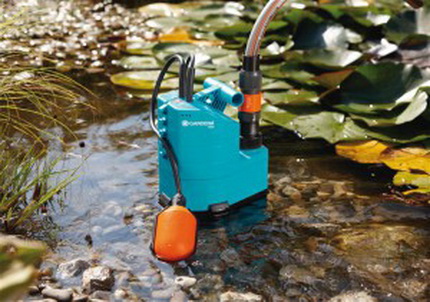
Drainage equipment can only work with slightly contaminated liquids. The value of solid impurities, depending on the type of apparatus, varies from 3 to 40 mm.
Whereas fecal pumps function in aggressive liquids with a complete absence of solids. They are necessarily equipped with grinders, which with the help of special blades completely eliminate large contaminants.
If we consider the device device in its most general form, it consists of several elements:
- Electrical engine.
- Impeller located on the shaft. Responsible for the movement of fluid inside the device. It can be placed directly on the engine or at some distance from it.
- Pump unit. It is equipped with an intake pipe. The fluid enters the device through the holes in the nozzle. Their diameter determines the size of the impurities with which the device can work.
- Sealed enclosure. Inside it are all the working elements.
- Circuit breaker. Turns on and off depending on the liquid level. This prevents flooding of the equipment or its so-called “dry running”.
Typical pump circuit:
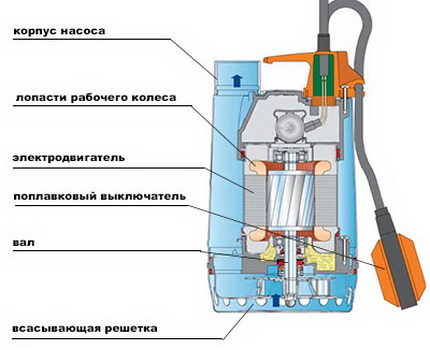
When the device is activated, an electric motor is launched, a rotating shaft with an impeller. A zone with rarefied air is formed around the moving blades, which reduces the pressure inside the chamber.
The fluid is drawn through nozzles with holes and passes into the device. Here, under the influence of centrifugal force, it is pushed to the outlet, from where it enters the pipe or outlet hose.
For normal operation of the pump, it is important that the amount of solid impurities inside the chamber does not exceed 10% of its volume. Another nuance. Standard drainers are not designed for pumping hot liquids.
They can do this for a short time, as the engine of the device cools, transferring heat to the pumped liquid. If you need to constantly pump hot water, you should choose a special model.
Types of Drainage Pumps
Depending on the installation location, two types of drainage equipment are distinguished - surface and submersible.
Surface pumping devices
Intended for mounting on the edge of a tank filled with pumping fluid. The inlet pipe lowers to the bottom of the tank, where it draws in water with impurities.
Such a device is able to function without human intervention, for which it connects to it float mechanismresponsive to the level of pumped liquid. When it rises, the float pops up, which is a signal to turn on the equipment and vice versa.
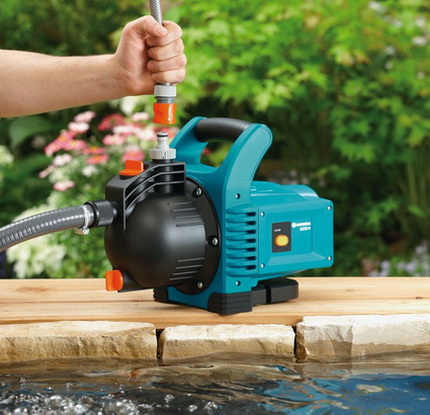
Surface devices are easy to maintain and mobile. They are quite easy to transport and install in a new place. All components of the equipment are available, therefore their repair does not cause difficulties. Surface devices most often have medium power. They can be used in pumping stations connected to wells or boreholes.
Submersible drainage pumps
Pumps of this type are designed to work directly in the pumped liquid, and therefore must be completely immersed in the tank.The main difference between the equipment is the lack of a suction pipe.
The liquid enters the pump through special openings located in the bottom of the structure. To protect the impeller of the device from large solid impurities, a strainer is mounted here.
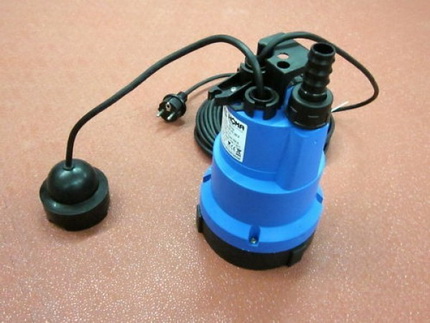
Devices function automatically, turn on only when a certain amount of liquid has accumulated. The equipment is necessarily equipped with reinforced electrical insulation, which is explained by its work in a liquid medium. The great advantage of submersible pumps is their high power and performance, noiselessness, durability, and safe operation.
An overview of a typical submersible drainage pump using the ASP 900 D INOX as an example:
The mechanism is used to pump water from wells, reservoirs, basements, etc. The “weak” place of the device is the holes in the bottom, which are often silted up, since the device is installed on the bottom of a reservoir or tank. This disadvantage is less inherent in models with suction openings located in the upper part of the housing.
Criteria for choosing the right equipment
Choosing a drain pump is easy enough. Be sure to consider several important criteria. How to decide on the most suitable model of a drainage device, in the smallest details is stated in one of popular articles our site.
For those who make a brief review and evaluate the selection criteria, we have given the main ones.
Characteristics of the pumped medium
Before buying a pump, you should determine what kind of fluid it will have to pump out. It should be relatively clean, without stones, without a high content of dirt or sand, and also without bottom sediment from silt.
This can be flooded rooms or cellars, tanks filled with rainwater, wells, ponds, etc. If the pump will sink into a reservoir, it should stand on a hard bottom.
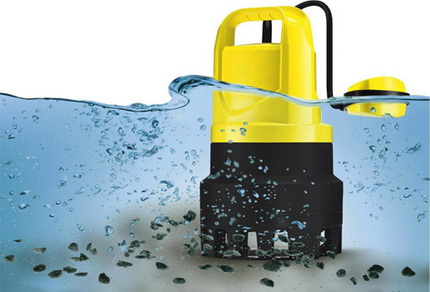
Therefore, it is installed in a suitable vat, bucket or on a special base plate. Each model is designed to work in a specific environment, that is, it indicates the maximum size of the impurities dissolved in the liquid, which the mechanism can skip without compromising its performance.
Depending on the contamination of the fluid, all drainage machines can be divided into groups:
- For lightly soiled or clean liquids with impurities up to 5 mm.
- For liquids of moderate pollution with inclusions not exceeding 25 mm.
- For contaminated, melt or rain water. Permissible particle size of contaminants from 25 to 38 mm.
In addition to the size of the impurities, it is also important to consider the temperature and chemical composition of the pumped liquid. Aggressive compounds can damage the pump, so you need to know exactly what its elements are made of.
Materials used in the manufacture
The service life of the drainage pump depends on the material used for the manufacture of its elements. The housing of the device may be made of plastic or metal.
In the first case, the cost of the device will be lower, which is more attractive to the buyer. However, the plastic case is not sufficiently resistant to mechanical damage and quite often cracks or deforms.

In this case, it can no longer be repaired. Metal housings are more durable and maintainable, so the pumps in this design last much longer.
One of the best materials for the case is cast iron and stainless steel, which can work in almost any environment. Another important detail is the material from which the pump blades are made.
They can be made of stainless steel or special technical polymer. Preferable in this case will be the second option. The particular impurities that are present in the polymer make it more resistant to aggressive environments and mechanical stresses.
A significant drawback is that they cannot be repaired. Metal blades wear out faster than plastic ones, therefore cheaper.
Type of circuit breaker
Almost all modern drainage pumps are equipped with circuit breakers that trigger a mechanism to achieve a given level of pumped liquid.
The device may be:
- Electronic built-in. Sufficiently complex and expensive node.
- Float. A simpler, more reliable and inexpensive item.
Circuit breakers of any type exclude the possibility of dry running of the pump, thereby preventing serious damage to it.
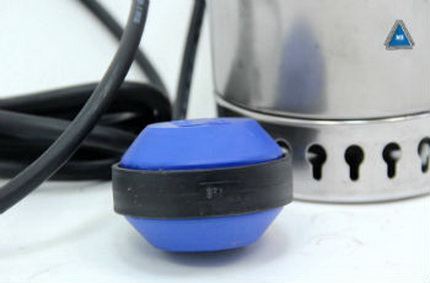
Drain Pump Performance
By productivity we mean the amount of liquid, measured in cubic meters, which the device can pump in one hour of operation. This indicator must be indicated in the passport of the device. You can determine the required performance by dividing the volume of the reservoir from which the fluid will be pumped out by the estimated operating time.
On average, for home use, a mechanism with a capacity of about 10 cubic meters is quite enough. m / hour. For professionals, models with a capacity of 100 cubic meters are suitable. m / hour.
Water pump head
It can vary in the range from 5 to 50 m. The head value depends on the type of pump, which determines the distance over which water is discharged, or the height of the pumped liquid.
These indicators are indicated in the technical documentation. They are related to each other in a proportion of 1:10. Thus, if the passport states that the pump can raise the liquid to a height of 5 m, then it can transfer it to a length of up to 50 m.
It is clear that these are average indicators that do not take into account any other parameters, for example, hose diameter. Therefore, for clarification, contact the seller. For the most general calculations, you can use such data.
For household models, it will be quite sufficient if the pressure specified in the technical documentation exceeds the calculated one by 3 m. If a powerful influx of water is expected or there is a lot of it, the "reserve" of pressure should be greater.
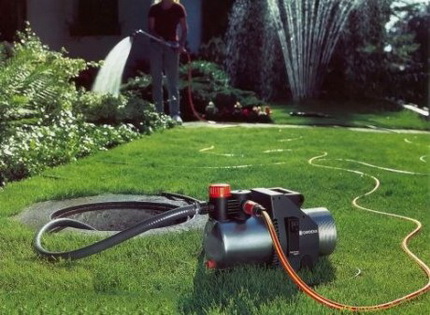
Outlet Diameter
For the most efficient operation of the pump, it is necessary to precisely select the dimensions of the outlet pipes. If pumping is intended, a small diameter model is suitable: from 0.5 to 1.5 inches.
In case of pumping out contaminated liquid, it is better to choose an 8-inch or even larger option. In addition, pipes for horizontal and vertical connection are available. You need to choose the right type of model.
And a few more important points. The hose that will be connected to the outlet pipe must have a similar diameter. For household needs, it is worth choosing portable lightweight models. They are more mobile and convenient to use.
It is worth asking about the residual liquid level that remains after the operation of the drainage pump. If you want to pump out the water “dry”, you should choose a model that leaves no more than 2 mm of liquid.
Brand models of pumping equipment
In the rating of drainage pumps, you can see both expensive devices and quite budget models. Let's talk about the most popular pumping equipment for the consumer.
#1. Italian brand Pedrollo
The company made itself known in the 70s of the last century. She quickly gained popularity with the high quality of her products, which successfully combined with a very reasonable cost.
Today, Pedrollo is one of the leaders in the production of pumps of various types. The line of drainage devices of this company is quite wide. In it you can highlight a particularly popular series of TOP.
These are drainage submersible units with an open impeller of a centrifugal type. Designed to operate in automatic mode for lifting and withdrawing fluids without abrasive particles. The pump housings of this series are made of technopolymer reinforced with fiberglass, which gives them increased impact resistance. The impeller and suction grille are also made of technical polymer.
One of the most popular models in the series is Pedrollo TOP Vortex. Like all pumps in the TOP range, the structural elements of the device are made of a “proprietary” technopolymer.
This allows him to work in various aggressive environments and pump not only water, but also chemicals. The device is intended for pumping dirty liquids and fecal effluents, the sizes of the solid fraction in which do not exceed 20 mm.
The model is designed for continuous use, able to function in partial immersion mode, equipped with an emergency shutdown device. This is a fairly powerful drainage pump, extremely easy to use.
Acquired to remove water from garages, basements, pools. It can be used for watering the site and even for organizing a small fountain in volume.
# 2. Russian pumps Dzhileks
Domestic manufacturer began to supply its products to the market in the 90s of the last century. Pumps of the Dzhileks brand are very in demand, due to their adaptation to Russian operating conditions.
For example, they are not so sensitive to frequent voltage drops in the network. In addition, they are of high quality, and their cost is an order of magnitude lower than that of imported analogues.
In addition, our country has a well-developed network of Dzhileks service centers, which ensures that there are no problems with repairs and spare parts. Drainage pumps of this brand are represented by a ruler under the general name Drainage.
These are submersible devices of various capacities made of special plastic or stainless steel. They can function in environments with contaminants ranging from 5 to 40 mm.
The devices are economical and have an impressive service life. One of the most popular models of the line is Drainage 200 / 10f. This is a fairly powerful pump with an immersion depth of up to 8 m.
The device is economical, its rated power is 880 watts. The device is equipped with a float switch, the operation of which can be adjusted by the user.
The drain pump has a high-strength plastic housing and is equipped with an overheat protection system. Among the advantages of the device, you can add the ability to operate for a long time in partial immersion mode. It can be used for drainage of wells, reservoirs, sewer sumps, etc. The cost of such a device is quite affordable.
# 3 German quality from Karcher
Time-tested German manufacturer Karcher produces reliable and durable drainage pumps. They are great for pumping even large volumes of liquids, as the capacity of some models is 18,000 l / h.
The easily recognizable Karcher brand drain pumps feature high build quality, power, performance and long life.
The Dirt series is designed for pumping dirty water, the size of the impurities in which does not exceed 30 mm. Pumps from this line are perfectly designed for work in ponds or flooded cellars, cellars. Karcher offers drainage pumps with a residual liquid level of no higher than 1 mm. They pump water almost dry.
For pumping clean or slightly contaminated liquids, the manufacturer offers the Flat series. These devices can be installed in pools or drainage wells. A feature of the line is that the devices leave a layer of water no higher than 1 mm, that is, they pump the liquid almost dry. Karcher pumps are equipped with an intelligent level sensor with an adaptive algorithm.
This allows the device to almost instantly respond to contact with the liquid and adapt to changing working conditions. The consumers praised the SP 3 Dirt.
This is a sufficiently powerful device for pumping dirty liquid with inclusions no larger than 20 mm in size. Equipped with a float switch and ceramic-granite gland, significantly increasing the life of the device.
#4. Inexpensive drain pumps from PATRIOT
Gardening equipment of the American brand Patriot appeared on the domestic market in 1999. The company sells equipment and tools under its own brand.
Products have an attractive balance between value and quality. There are four samples in the line of drainage pumps. One of the most popular models is the PATRIOT F 300, which is notable for its low price and good performance.
Pumps for pumping dirty water of the Patriot brand are distinguished by an attractive ratio of affordable cost and high quality.
The device works with dirty water with inclusions no more than 5 mm in diameter, equipped with a float switch. The pump can be lowered into the pumped medium to a depth of not more than 5 m.Device throughput 3.5 m3/ h
At the same time, it has rather modest dimensions and relatively low power consumption. The drain pump is easy to maintain and can be used to work in a pond or well, weighs only 3 kg.
#5. GNOM dirty water pumps
Produced by the Moscow Pumping Plant. In the line of drainage devices there are household and professional models. The devices are equipped with a built-in hermetically sealed electric motor.
Designed to work with liquids with a density of up to 1100 kg / m³. Permissible size of impurities is 5 mm. Devices designed to operate in a liquid medium with a temperature of 35 to 60 ° C are marked “T”.
In the line of pump drainage equipment, one of the most popular varieties is model 16-16. This is a 1.1 kW electric submersible pump. The pressure of the device is 16 m, the fluid supply is up to 18 m. Such characteristics allow the device to be used for pumping sandy or clay waters from deep trenches and pits, flooded basements of a large area.
The GNOM 16-16D drainage pump can be used to lower the level of continuously abiding groundwater. In addition, the equipment is used for irrigation of greenhouses, greenhouses and gardens. The throughput is 16 m3/ h
An air release button is installed on the device, which speeds up its launch and ensures stable operation of the device. I must say that many owners of private estates and cottages consider this particular model to be one of the best.
Conclusions and useful video on the topic
Video # 1. Types of drainage pumps:
Video # 2. Important selection criteria for the drain pump:
Video # 3. How to choose a drain pump:
The drainage pump must be in the economy of a country house or cottage. Its functionality is quite wide. The device will successfully cope with pumping water from a flooded basement or well, and will also help the owner in watering the site.
When choosing drainage equipment, it is important to clearly understand how it will be used. This is the only way to choose a model that is optimal for specific conditions. It should be remembered that its service life directly depends on the quality of installation and operating conditions.
You can ask a question or tell about your own experience in the selection and use of a drainage pump located below the block. Please comment on the article. We or site visitors will be happy to answer.

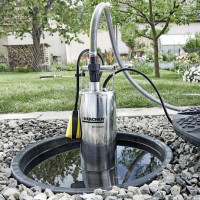 How to choose a pump for a well: recommendations for choosing pumping equipment
How to choose a pump for a well: recommendations for choosing pumping equipment 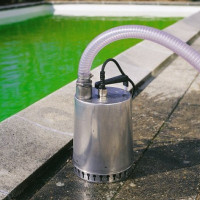 How to choose a pump for pumping dirty water: selection rules and an overview of the best models
How to choose a pump for pumping dirty water: selection rules and an overview of the best models 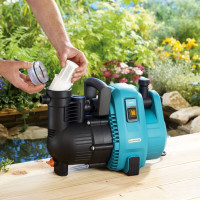 TOP-12 centrifugal pumps for a well: rating of the best + recommendations for choosing equipment
TOP-12 centrifugal pumps for a well: rating of the best + recommendations for choosing equipment  Rating of pumps for drip irrigation: TOP-12 of the best offers + recommendations to customers
Rating of pumps for drip irrigation: TOP-12 of the best offers + recommendations to customers 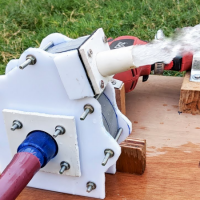 How to make a water pump with your own hands: we disassemble the 13 best home-made options
How to make a water pump with your own hands: we disassemble the 13 best home-made options 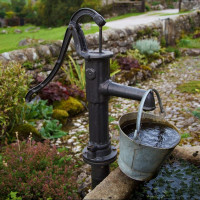 Hand pump for a well: types of equipment, characteristics, their pros and cons
Hand pump for a well: types of equipment, characteristics, their pros and cons  How much does it cost to connect gas to a private house: the price of organizing gas supply
How much does it cost to connect gas to a private house: the price of organizing gas supply  The best washing machines with dryer: model rating and customer tips
The best washing machines with dryer: model rating and customer tips  What is the color temperature of light and the nuances of choosing the temperature of the lamps to suit your needs
What is the color temperature of light and the nuances of choosing the temperature of the lamps to suit your needs  Replacement of a geyser in an apartment: replacement paperwork + basic norms and requirements
Replacement of a geyser in an apartment: replacement paperwork + basic norms and requirements
In the spring, when the basement was flooded during snow melt, I had to urgently buy a drainage pump. I chose carefully, but my budget was limited. He took a model of a submersible pump, in which holes were often clogged. I had to additionally put a small mesh in 2 layers (a piece of mosquito net remained). Partially solved the problem. All the same, it’s better not to save on such purchases.
Need a budget automatic drainage pump to pump water from the subfloor in the garage. Depth is approximately two meters. Advise?
The most budgetary option of the proven ones is the Kid 10M, it also copes well with dirty water. If you definitely need a drainage pump, then pay attention to the JILEX Drainage Machine 200/25, a good model for quite reasonable money.
What I do not recommend is Chinese drainers, which are sold, for example, in Leroy Merlin or from other networkers. Break very quickly, just spend the money.